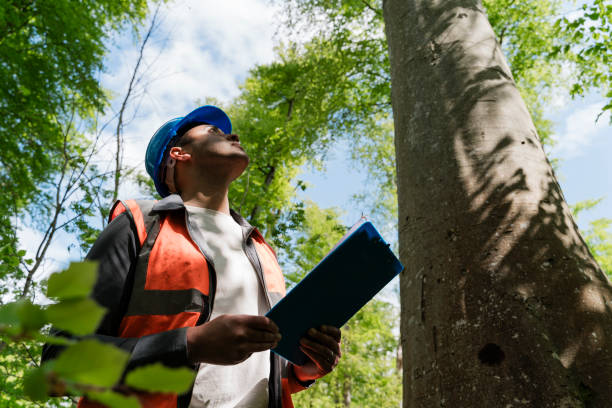Curious about how arborists address tree health issues?
Their approach is both thorough and methodical.
Arborists carefully inspect a tree’s structure, leaves, and bark to detect any signs of concern.
However, it doesn’t stop there—advanced tools such as increment borers and resistographs uncover hidden details about a tree’s growth and stability.
The environment also plays a crucial role in a tree’s health.
Factors like soil quality and pollution are key considerations in forming a complete diagnosis.
This detailed process may change how you see the trees around you.
(h2) Visual Inspection Techniques
Visual inspection is a crucial first step in assessing a tree’s health. Here are some key areas to focus on:
(h3)Tree Structure:
- Dead branches: Look for signs of decay or breakage.
- Unusual leaf coloration: Observe changes in leaf color or texture.
- Sparse canopy: A thinning canopy can indicate stress or disease.
- Bark condition: Examine the bark for peeling, cracking, or cankers.
(h3)Leaves and Needles:
- Discoloration: Look for yellowing, browning, or wilting.
- Spots or fungal growth: Check for signs of disease.
- Holes or chewed edges: Look for evidence of insect damage.
(h3)Root Area:
- Mounding of soil: This can indicate root problems.
- Root exposure: Exposed roots can be a sign of stress or damage.
(h3)Environmental Factors:
- Construction activity: Nearby construction can damage roots or change soil conditions.
- Soil compaction: Compacted soil can limit root growth and water absorption.
- Water availability: Changes in water availability can stress the tree.
- Pests and diseases: Look for visible signs of insect infestations or fungal growth.
By carefully observing these visual cues, you can gather valuable information about the tree’s health and determine the next steps for treatment or management.
(h2) Diagnostic Tools and Equipment
Sometimes, visual inspections alone can’t reveal all the issues affecting a tree’s health.
Diagnostic tools and specialized equipment are essential for a deeper analysis in such cases.
(h3) Key Diagnostic Tools Used by Arborists
- Increment Borer: This tool extracts a core sample from the tree with minimal damage. Examining the sample allows you to evaluate growth patterns and check for signs of decay or disease.
- Resistograph: By measuring the resistance of the wood as a tiny drill penetrates it, the resistograph provides vital insights into the tree’s structural integrity.
- Root Collar Excavation: When root problems are suspected, this method involves gently removing soil around the tree’s base to inspect the roots for issues like girdling or rot.
(h3)Advanced Diagnostic Techniques
- Sonic Tomography: This device uses sound waves to map the tree’s internal structure visually. It helps pinpoint areas of decay, allowing for more accurate diagnoses.
These tools provide critical data that assist arborists in making informed decisions about a tree’s health and the necessary treatments.
(h2) Analyzing Environmental Factors
Understanding the complexities of tree health requires considering the numerous environmental factors that affect it.
Key elements such as location, climate, soil, and external threats can all contribute to a tree’s well-being.
(h3) Key Environmental Factors to Consider
- Location and Climate: Assess whether the tree is in an area with suitable conditions. Temperature extremes or a lack of water can affect the tree’s health.
- Soil Quality: Look for issues like nutrient deficiencies, pH imbalances, or compacted soil, as these factors can hinder root growth and the tree’s ability to absorb nutrients.
- Pollution and Air Quality: Urban settings expose trees to pollutants that can compromise their health. Consider nearby construction, road salt usage, or other potential contaminants.
(h3) Additional Stress Factors
- Wind, Storms, and Drought: These natural occurrences can weaken trees over time, making them more vulnerable to other threats.
- Pests and Diseases: Biotic factors such as insect infestations or fungal infections often arise when environmental stressors occur.
By thoroughly examining these factors, you can better understand the challenges impacting a tree’s health, allowing for more effective care and management.
Arborists take a holistic approach when diagnosing tree health issues, combining visual inspections with advanced tools and environmental analysis.
Arborists examine every aspect of a tree’s well-being, from its structure to its surroundings, to provide a complete picture.
This process ensures trees receive the most accurate care and treatment, promoting longevity and vitality.
The next time you walk past a tree, you’ll have a deeper appreciation for the careful attention it requires.

